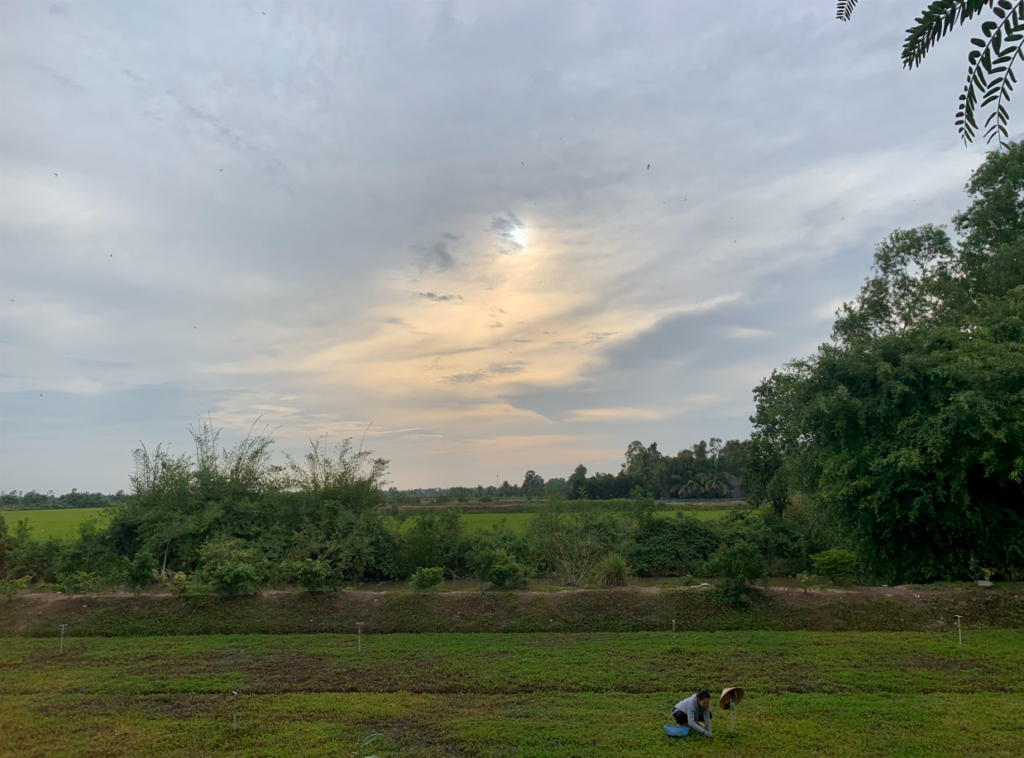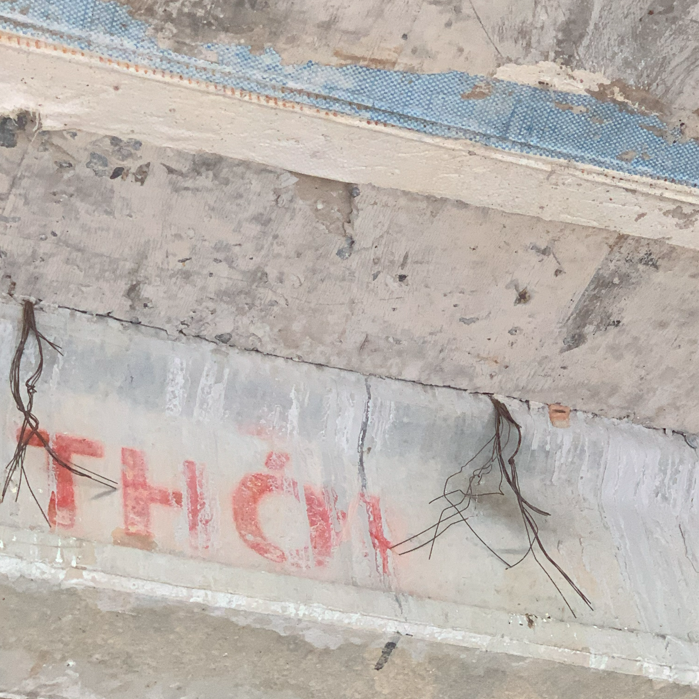LONG AN & ĐỒNG THÁP, VIỆT NAM – It is August, the end of rice harvesting season in Nguyễn Sơn village, but Trần Thanh Bảy is already tending to his next crop. Every day, the 65-year-old farmer wakes up at 4.30am to inspect the field. For an hour, he diligently checks for pests, ensuring pesticides and fertilizers are sprayed promptly.
Such an attentive process is necessary because Bảy is employing a new rice farming method, which requires daily instead of monthly checkups. He is among more than 150,000 farmers in Long An and Đồng Tháp provinces who have been growing low carbon rice as part of the World Bank-backed Vietnam Sustainable Agriculture Transformation Project (VnSAT) since 2015.
The chief of his village, Bảy was first persuaded in 2018 by officers from the Ministry of Agriculture and Rural Development to join the project. Intrigued by VnSAT’s ambitious environmental goals, which were to reduce the industry’s greenhouse gas emissions while enhancing yield and grain quality, he rallied 70 farmers in the Hoàng Gia cooperative to take part.
Five years later, many including Bảy are having doubts about the project as they experienced higher production costs, stagnated yields and what they perceived as ineffective management of project funding.

Ambitious goals
The project started with a sizeable goal: to reduce about 1 MtCO2e of methane emissions annually from rice farming in Vietnam’s Mekong Delta, which produces more than half the country’s rice. The industry emits about 49.7 MtCO2e of methane annually, contributing to 50% of agriculture’s methane emissions and 15% of the country’s total greenhouse gas emissions.
To realize this goal, the US$301 million project trained farmers on two new rice cultivation techniques and invested in infrastructure that helped facilitate the change. The techniques, developed by the International Rice Research Institute (IRRI) based in the Philippines, mainly targets the industry’s excessive use of water, fertilizer and pesticides – major sources of methane, nitrous oxide and other greenhouse gas emissions.
The first technique, called “One Must Do, Five Reductions” (1M5R; 1 Phải 5 Giảm in Vietnamese), encourages the use of certified healthy seeds (One Must Do) and a reduction in the seeding rate, pesticide, fertilizer, water and post-harvest losses.
The second, “Three Reductions, Three Gains” (3R3G; 3 Giảm 3 Tăng in Vietnamese), imposes reductions on the use of seeds, nitrogen fertilizer and pesticides, in order to gain savings in production costs, health benefits for farmers and environmental protection.
Both techniques require the exclusive use of organic fertilizers to increase plant and soil health, and to lower greenhouse gas emissions. Farmers are also advised to reduce irrigation, which further abates methane emissions and helps crops become more drought resistant. In the drought-prone and dams-intensive Mekong Delta, saving water is critical for farmers to adapt to the impacts of climate change.
According to results collated by VnSAT and the World Bank’s Agriculture Competitiveness Project (ACP), 1M5R alone has the potential to increase rice yields by roughly 5-8%, to lower production costs by 22% and raise profits by 29-67%.
Economic challenges
In both Đồng Tháp and Long An provinces, however, many farmers claim the intended results have yet to emerge. Tiến Cường cooperative members in Đồng Tháp found that low carbon techniques required more skills and attention than traditional methods, yet returns for such efforts have not been satisfactory.
“Farmers have to work harder because we have to visit the paddy fields more frequently to check the health of the rice,” said Tiến Cường’s leader Nguyễn Văn Trãi. “We put in more time and commitment, but businesses purchase our products at the same price as [those of] traditional rice farmers.”
Many farmers in both Tiến Cường and Hoàng Gia cooperatives told the reporter that the IRRI’s methods have not significantly reduced production costs.
“Organic pesticides cost more than conventional ones,” explained Trãi. “Input costs might [have] decreased [due to planting fewer] seeds, but the effort is higher. The yield is either lower or equivalent to those practicing traditional rice cultivation.”

Farmer Bảy of Long An also pointed out that despite high cultivation costs, VnSAT did not provide participants with any assistance on prices, which created unease among farmers given the rice market’s volatility.
“We want the project to provide [indications of] how much we can possibly sell if we apply the new cultivation methods in our paddy fields,” he added.
Despite the economic challenges, the project did yield several benefits. During training, VnSAT officers showed farmers how to identify the pests and diseases that affect their yields and which suitable pesticides to use.
“Previously, the farmers did not know about the diseases affecting rice, so they often used four to five types of pesticides at once. The more pesticides you use, the higher the cost,” said Trãi.
Bảy noted that participating farmers were sympathetic to the aims of the project: “We understand the environmental benefits of the techniques. However, we struggle daily to make a living, so we prioritize economic benefits.”
According to Lê Anh Tuấn, the vice-director of Cần Thơ University’s Climate Change Research Institute in the Mekong Delta, low carbon methods promoted by VnSAT could effectively reduce emissions, but the program needed to be scaled up and implemented consistently over longer periods to achieve significant results.
“The new farming methods are meaningful when combined with a departure from traditional cultivation practices,” said Tuấn, referring to high emitting activities such as stubble burning and over-irrigation.
Yet the time and costs that VnSAT demands have meant some farmers have resorted to partial implementation only. Dũng, a Tiến Cường cooperative farmer, for example, reduced his seed quantities and irrigation as advised by VnSAT, but still used chemical pesticides and fertilizers because they were cheaper than organic ones.
Discontent in fund managements
Another key focus of the VnSAT project was the development of infrastructure that supported the new rice farming techniques, which included equipment for high-quality rice processing, production and distribution such as roads, bridges, drying and storage plants, power lines and pumping stations.
Farming communities, however, question the quality and ineffectiveness of such projects.
In 2021, VnSAT funded the construction of a 4.5km road that passed Bảy’s house. Designed to facilitate rice transportation, the road has already needed multiple repairs. Meanwhile, a bridge next to Bảy’s house, also built in 2021, has developed serious cracks.
“It is very dangerous. The community has been demanding that the bridge to be repaired, but it hasn’t been [fully] fixed,” said Bảy.


Other projects jointly invested in by VnSAT and private entities have come under fire for their lack of foresight. In 2015, the Tiến Cường farming cooperative invested more than $650,000 in the construction of a drying and storage facility funded by VnSAT, only to find it neglected by farmers and rice buyers, who preferred to get the rice immediately after harvesting to ensure the highest quality. Tiến Cường has incurred several hundred thousand dollars of losses each year since, said Trãi.
In Nhơn Hòa Lập, another Long An farming commune, a $150,000 VnSAT-built pumping station completed in 2022 was also abandoned due to a lack of demand and investor interest.
Such shortfalls could have been mitigated if the project considered community inputs in the early stages, some farmers contend. “The [pumping station] project began construction without consulting the local residents,” said a member of Hoàng Gia cooperative who wished to remain anonymous. “So when it was completed, no one used it.”
Second phase
In March 2023, Vietnam’s Ministry of Agriculture and Rural Development proposed the second phase of VnSAT, which aimed to introduce high-quality rice crops across one million hectares by 2030. The World Bank has shown interest in establishing a $20 million grant program with Vietnamese private banks to arrange the necessary loans for farmers.
Phase 1 participants who spoke to Mekong Eye said the project needed significant improvement to attract more buy-in from farmers. “The central government must collaborate closely with local authorities to understand what needs to be invested in, and how to invest effectively,” said Trãi.
Trãi added that VnSAT should establish a solid connection with businesses to ensure large-scale consumption of its new rice varieties – farmers need to know who they can sell these products to and how much they can earn.
At present, the Tiến Cường cooperative sells its products to small-scale traders, who resell to major companies. Trãi suggested VnSAT boost rice production volumes, which would make it easier for Tiến Cường to negotiate larger deals and sell directly to big companies.
“The quantity of emissions-reduced rice on its own is too minimal for widespread consumption,” he said. “Companies lack the incentive to purchase it at a premium.”
Another solution to this lack of incentive could be the creation of a certification for VnSAT rice. Trần Phương Nam, who directs the major southern Vietnamese rice producer VinaRice, told the reporter the company was willing to pay a higher price for low-carbon rice if there was certification by a third party.
“We need to know the origin of the plant and the rice production process to determine the value of the final product,” said Nam.
Despite the setbacks, Bảy is hopeful about next year’s harvest and rice price. He also anticipates charging more for his rice if the project’s second phase is implemented. Like Trãi, he hopes local communities will be consulted in the future. “VnSAT should survey farmers in advance to understand what we really want,” Bảy told the reporter.
As of November 2023, the reporter has not yet received a response from the World Bank to its request for comment.
This story was originally published on November 15, 2023, on China Dialogue. Its content has been modified to suit the editorial style of Mekong Eye.





